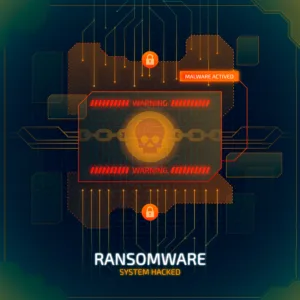
Table of Contents
In the ever-evolving landscape of cyber threats, ransomware remains one of the most pervasive and damaging forms of malware. Among the plethora of ransomware variants, Phobos has emerged as a particularly notorious threat, wreaking havoc on organizations and individuals alike.
In this comprehensive guide, we delve into the workings of Phobos ransomware, its modus operandi, and crucially, effective countermeasures to mitigate its impact.
Introduction to Phobos Ransomware
Phobos ransomware belongs to the family of file-encrypting malware that infiltrates systems, encrypts files, and demands a ransom in exchange for decryption keys. Named after the Greek god of fear, Phobos strikes terror into the hearts of its victims by encrypting crucial files, rendering them inaccessible. First identified in late 2018, Phobos has since evolved, becoming increasingly sophisticated and pervasive.
Modus Operandi of Phobos Ransomware
1. Propagation:
Phobos typically infiltrates systems through phishing emails, malicious attachments, or exploit kits. Once a user unwittingly executes the malware, it begins its insidious encryption process.
2. Encryption:
Upon infiltration, Phobos swiftly identifies and encrypts a wide array of file types, including documents, images, videos, and databases. It employs robust encryption algorithms such as AES or RSA to ensure that the files remain inaccessible without the decryption key.
3. Ransom Note:
After encrypting the files, Phobos leaves behind ransom notes, usually in the form of text files or pop-up messages, demanding payment in cryptocurrency, often Bitcoin, in exchange for the decryption key. The ransom demands can vary widely, ranging from hundreds to thousands of dollars.
4. Intimidation Tactics:
To coerce victims into paying the ransom, Phobos employs intimidation tactics, threatening to permanently delete the encrypted files or exponentially increase the ransom amount if not paid within a specified timeframe.
5. Data Exfiltration:
In some cases, Phobos may also exfiltrate sensitive data before encryption, leveraging it as leverage to compel victims to pay the ransom or to sell the stolen data on the dark web.
Countermeasures Against Phobos Ransomware
Given the nefarious nature of Phobos ransomware and its potential to wreak havoc, it is imperative for organizations and individuals to adopt robust countermeasures to mitigate the risks.
Here are some effective strategies:
1. Educate Users:
The first line of defense against ransomware attacks is user education. Organizations should conduct regular training sessions to educate employees about phishing emails, malicious attachments, and other common vectors of ransomware infiltration. By fostering a culture of cybersecurity awareness, organizations can significantly reduce the likelihood of successful Phobos attacks.
2. Implement Robust Endpoint Protection:
Deploying advanced endpoint protection solutions equipped with features such as behavior-based detection, heuristic analysis, and real-time threat intelligence can help detect and thwart Phobos ransomware before it can inflict damage.
3. Backup Regularly:
Regularly backing up critical data to offline or cloud-based storage repositories is essential for mitigating the impact of ransomware attacks. In the event of a Phobos infection, organizations can restore encrypted files from backups, minimizing downtime and financial losses.
4. Patch and Update Systems:
Ensure that all systems, applications, and software are regularly patched and updated to mitigate vulnerabilities exploited by Phobos and other ransomware variants. Vulnerable systems present low-hanging fruit for cybercriminals, making timely patching a crucial aspect of ransomware defense.
5. Deploy Network Segmentation:
Segmenting networks can limit the lateral movement of ransomware within an organization’s infrastructure, containing the impact of a Phobos infection and preventing it from spreading across critical systems and servers.
6. Implement Access Controls:
Restricting user privileges and implementing least privilege access policies can limit the ability of Phobos ransomware to access and encrypt sensitive files, thereby reducing the potential impact of an attack.
7. Incident Response Plan:
Develop and regularly update an incident response plan that outlines the steps to be taken in the event of a Phobos ransomware attack. This should include procedures for isolating infected systems, communicating with stakeholders, and coordinating with law enforcement authorities.
Conclusion
Phobos ransomware poses a significant threat to organizations and individuals, capable of causing widespread disruption and financial losses. By understanding its modus operandi and implementing robust countermeasures, organizations can fortify their defenses and mitigate the risks posed by Phobos and other ransomware variants.
From user education and endpoint protection to regular backups and incident response planning, a multi-layered approach to cybersecurity is essential in safeguarding against the pernicious threat of Phobos ransomware.
FAQ for Phobos Ransomware
1. What is Phobos Ransomware?
Phobos ransomware is a type of malware that infiltrates computer systems, encrypts files, and demands a ransom payment in exchange for decryption keys. It derives its name from the Greek god of fear, reflecting its ability to strike terror into the hearts of its victims.
2. How Does Phobos Ransomware Infect Systems?
Phobos typically infiltrates systems through phishing emails, malicious attachments, or exploit kits. Once a user unwittingly executes the malware, it begins encrypting files on the infected system.
3. What Types of Files Does Phobos Encrypt?
Phobos is capable of encrypting a wide array of file types, including documents, images, videos, databases, and more. It targets files stored on local drives, network shares, and attached storage devices.
4. What Encryption Algorithms Does Phobos Ransomware Use?
Phobos ransomware employs robust encryption algorithms such as AES (Advanced Encryption Standard) or RSA (Rivest-Shamir-Adleman) to encrypt files securely. These encryption techniques render the files inaccessible without the decryption key.
5. How Does Phobos Ransomware Demand Payment?
After encrypting files, Phobos leaves behind ransom notes, typically in the form of text files or pop-up messages, demanding payment in cryptocurrency, often Bitcoin. The ransom demands can vary widely, depending on the perceived value of the encrypted data and the cybercriminals’ discretion.
6. Should I Pay the Ransom to Decrypt My Files?
It is generally not recommended to pay the ransom demanded by Phobos ransomware or any other ransomware variant. Paying the ransom does not guarantee that you will receive the decryption key, and it only incentivizes cybercriminals to continue their malicious activities.
7. Can I Decrypt My Files Without Paying the Ransom?
In some cases, security researchers and cybersecurity firms may develop decryption tools capable of unlocking files encrypted by Phobos ransomware. However, these tools are not always available, and their effectiveness can vary depending on the specific encryption techniques used by the malware.
8. How Can I Protect Myself Against Phobos Ransomware?
To protect against Phobos ransomware and similar threats, it is essential to implement robust cybersecurity measures, including regular data backups, endpoint protection solutions, user education and awareness training, patch management, network segmentation, and incident response planning.
9. What Should I Do If My System Is Infected with Phobos Ransomware?
If your system is infected with Phobos ransomware, immediately disconnect it from the network to prevent further spread. Contact your organization’s IT security team or a reputable cybersecurity firm for assistance in containing the infection, assessing the damage, and initiating recovery efforts.
10. Can I Report Phobos Ransomware Attacks to Law Enforcement?
Yes, victims of Phobos ransomware attacks can and should report the incident to law enforcement authorities, such as the local police department or national cybercrime agencies. Reporting such incidents can help authorities track and apprehend cybercriminals and potentially recover stolen data.
Read more on https://cybertechworld.co.in for insightful cybersecurity related content.




















Your article helped me a lot, is there any more related content? Thanks!